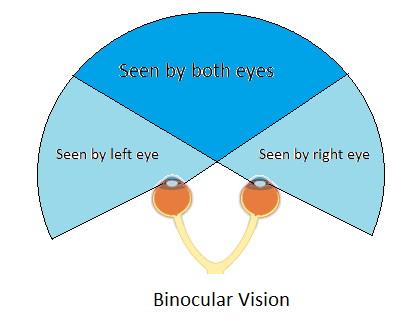
The vision of man is
A. Monocular
B. Binocular
C) Opposition
D) None of the above
Answer
557.1k+ views
Hint: Vision refers to the ability of man to see the beautiful world around him. It is one of the main sensory capabilities of man. Humans have two eyes and each of them form individual images. These images are combined and processed as a single image in the brain.
Complete answer: Vision is the sensory ability of an organism to see the surrounding environment. Vision provides one ability to search for food, to find suitable habitat, to predate, and to stay safe. Different organisms have different types of vision capabilities based on the structure of their eyes. The ability to see only from one eye is called monocular vision. Mono means single and ocular means eye. Both of the eyes form separate images that provide a wide view but less depth. Animals having eyes on both sides of their head have monocular vision. Binocular vision refers to the formation of two different images by both eyes which are seen as one. A three-dimensional image is formed in animals having two eyes facing the same direction. A wider field of view is formed as two images combine to form one. It is present in human vision. The vision of man is binocular due to the presence of two eyes that form two different images and then combine them.

Apposition vision is seen in insects majorly. They have compound eyes that make thousands of tiny images that are combined as one. A vast field of vision is created with more depth and detail.
So, option B is the right answer.
Note: Binocular vision shows some very interesting phenomena. Utricular discrimination is the ability to tell which eye has been stimulated by light. Eye dominance occurs when an organism uses one eye to aim at detail even if both eyes are open. Singleness of vision occurs when an object is seen as one through both eyes even though both eyes have their own image of the object.
Complete answer: Vision is the sensory ability of an organism to see the surrounding environment. Vision provides one ability to search for food, to find suitable habitat, to predate, and to stay safe. Different organisms have different types of vision capabilities based on the structure of their eyes. The ability to see only from one eye is called monocular vision. Mono means single and ocular means eye. Both of the eyes form separate images that provide a wide view but less depth. Animals having eyes on both sides of their head have monocular vision. Binocular vision refers to the formation of two different images by both eyes which are seen as one. A three-dimensional image is formed in animals having two eyes facing the same direction. A wider field of view is formed as two images combine to form one. It is present in human vision. The vision of man is binocular due to the presence of two eyes that form two different images and then combine them.

Apposition vision is seen in insects majorly. They have compound eyes that make thousands of tiny images that are combined as one. A vast field of vision is created with more depth and detail.
So, option B is the right answer.
Note: Binocular vision shows some very interesting phenomena. Utricular discrimination is the ability to tell which eye has been stimulated by light. Eye dominance occurs when an organism uses one eye to aim at detail even if both eyes are open. Singleness of vision occurs when an object is seen as one through both eyes even though both eyes have their own image of the object.
Recently Updated Pages
The number of solutions in x in 02pi for which sqrt class 12 maths CBSE

Write any two methods of preparation of phenol Give class 12 chemistry CBSE

Differentiate between action potential and resting class 12 biology CBSE

Two plane mirrors arranged at right angles to each class 12 physics CBSE

Which of the following molecules is are chiral A I class 12 chemistry CBSE

Name different types of neurons and give one function class 12 biology CBSE

Trending doubts
One Metric ton is equal to kg A 10000 B 1000 C 100 class 11 physics CBSE

What is 1s 2s 2p 3s 3p class 11 chemistry CBSE

Discuss the various forms of bacteria class 11 biology CBSE

State the laws of reflection of light

Explain zero factorial class 11 maths CBSE

An example of chemosynthetic bacteria is A E coli B class 11 biology CBSE




